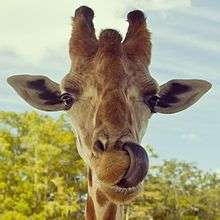Prehensility
Prehensility is the quality of an appendage or organ that has adapted for grasping or holding. The word is derived from the Latin term prehendere, meaning "to grasp".
Examples
Appendages that can become prehensile include:
- The hands of primates are all prehensile to varying degrees
- Prehensile feet:
- Prehensile tails – Many extant lizards have prehensile tails (geckos, chameleons, and a species of skink). Seahorses grip seaweed with their tails. Several fossil animals have been interpreted as having prehensile tails, including several Late Triassic drepanosaurs,[1] and possibly the Late Permian synapsid Suminia.[2]

Giraffe's prehensile tongue
- Tongue – of giraffes in particular
- Nose – elephants, tapirs
- Lips – lake sturgeon, orangutans, horses and rhinos
- Cephalopod arm – arms such as those of octopuses
- Upper lip, such as that of the West Indian manatee
- Penises, such as that of the tapir[3]
Uses
Prehensility affords animals a great natural advantage in manipulating their environment for feeding, digging, and defense. It enables many animals, such as primates, to use tools to complete tasks that would otherwise be impossible without highly specialized anatomy. For example, chimpanzees have the ability to use sticks to obtain termites and grubs in a manner similar to human fishing. However, not all prehensile organs are applied to tool use; the giraffe tongue, for instance, is instead used in feeding and self-cleaning.
References
- Silvio Renesto, Justin A. Spielmann, Spencer G. Lucas, and Giorgio Tarditi Spagnoli. (2010). The taxonomy and paleobiology of the Late Triassic (Carnian-Norian: Adamanian-Apachean) drepanosaurs (Diapsida: Archosauromorpha: Drepanosauromorpha). New Mexico Museum of Natural History and Science Bulletin. 46:1–81
- Jörg Fröbisch and Robert R. Reisz. (2009). The Late Permian herbivore Suminia and the early evolution of arboreality in terrestrial vertebrate ecosystems. Proceedings of the Royal Society B. Online First doi:10.1098/rspb.2009.0911
- Andrew, Danielle (31 July 2015). "Watch A Tapir Scratch An Itch With His Enormous, Prehensile Penis". IFLScience. Retrieved 16 July 2018.
This article is issued from Wikipedia. The text is licensed under Creative Commons - Attribution - Sharealike. Additional terms may apply for the media files.
.png)